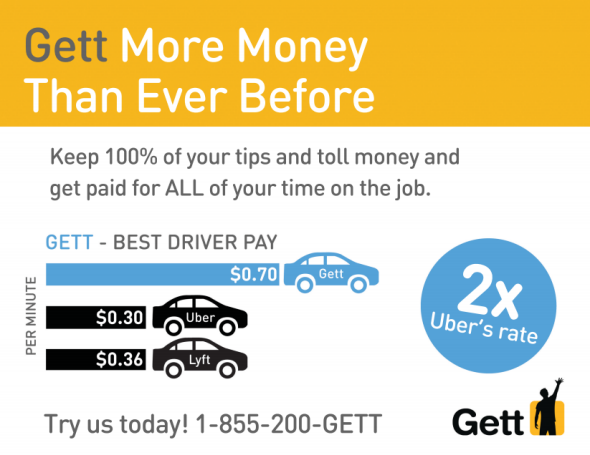Sometimes it’s easy to forget that there are contestants in the on-demand car-service game other than Uber and Lyft. One of them is Gett, and starting today it’s making a big move to get more recognition from arguably the most important players: for-hire drivers.
Gett announced on Wednesday that it will begin paying drivers on its platform a flat rate of $0.70 per minute—an amount it says will double the typical payout for drivers on competing services UberX and Lyft. The $0.70 will come after sales tax and commission, and is separate from any money drivers make in customer tips. Under the new payment system, Gett claims, drivers working 40 hours per week will be able to touch six figures for the year. “Gett more money than ever before” is the tag line.
The $0.70 rate for drivers is rolling out just over a month after Gett announced a similarly attractive incentive for New York City riders: flat $10 fees to take any trip in Manhattan. There’s no price-surging and no added cost for time ticking away as you sit in midtown traffic. “We don’t try to cut corners to find a cheaper price point,” says Ron Srebro, Gett’s chief executive. “We always play fair, we always work only with licensed drivers.”
In chasing that goal, the company is stepping into uncertain economic territory. Gett has now drastically cut fares on the consumer side of its platform and presumably increased expenditures on the driver side. That doesn’t make a whole lot of sense—how can it offset higher costs to drivers while cutting prices for consumers? Srebro was reluctant to elaborate on how Gett plans to wrangle the finances of all this but admitted that Gett has not tested this particular pay-and-fare model in any of its other markets. (Gett is active in 24 cities including London, Moscow, St. Petersburg, Jerusalem, Tel Aviv, and Haifa.)
“I do think categorically that this is totally sustainable,” Srebro says. “The $10 promotion for us is sustainable. The driver pay is sustainable. And even for us if we need to change that balance a little, it will be sustainable.” It’s certainly possible that in the short term, Gett’s markets abroad—which Srebro says are bigger, more established, and more competitive with Uber—will help subsidize losses in New York. “This is a growth business so no, we’re not losing a lot of money,” he adds.
What’s most interesting about Gett’s decision is the implicit understanding that drivers are every bit as important—if not more so—than customers on its two-sided platform. So far, Uber and Lyft have largely played to the consumers’ interests as they undercut each others’ fares and pushed down driver pay as well. But lately drivers have grown frustrated with this system. When Uber tried to force its high-end SUV drivers to take cheap UberX fares, the drivers protested until Uber backed down. More and more, drivers are shuttling back and forth between Uber and Lyft and other on-demand car services to work for the one that currently pays the best rate and treats its workers the fairest.
Gett isn’t as big as Uber and Lyft, and it certainly isn’t as well-known in the U.S. But if Gett can draw enough drivers from its competitors to slow down their services without going broke in the process, it has a shot at carving out a bigger space for itself in the ride-sharing market.
